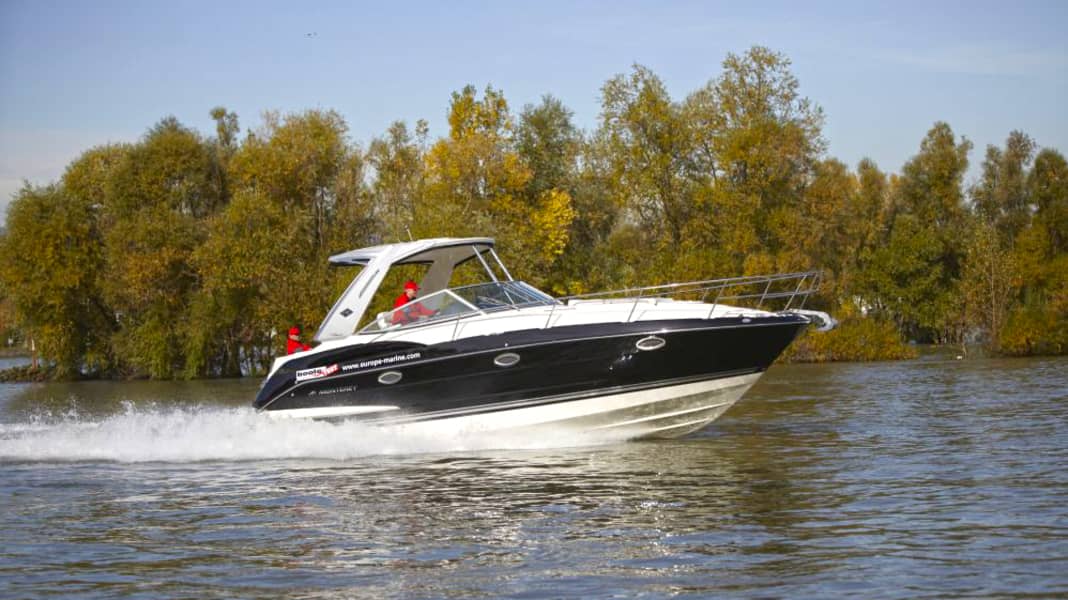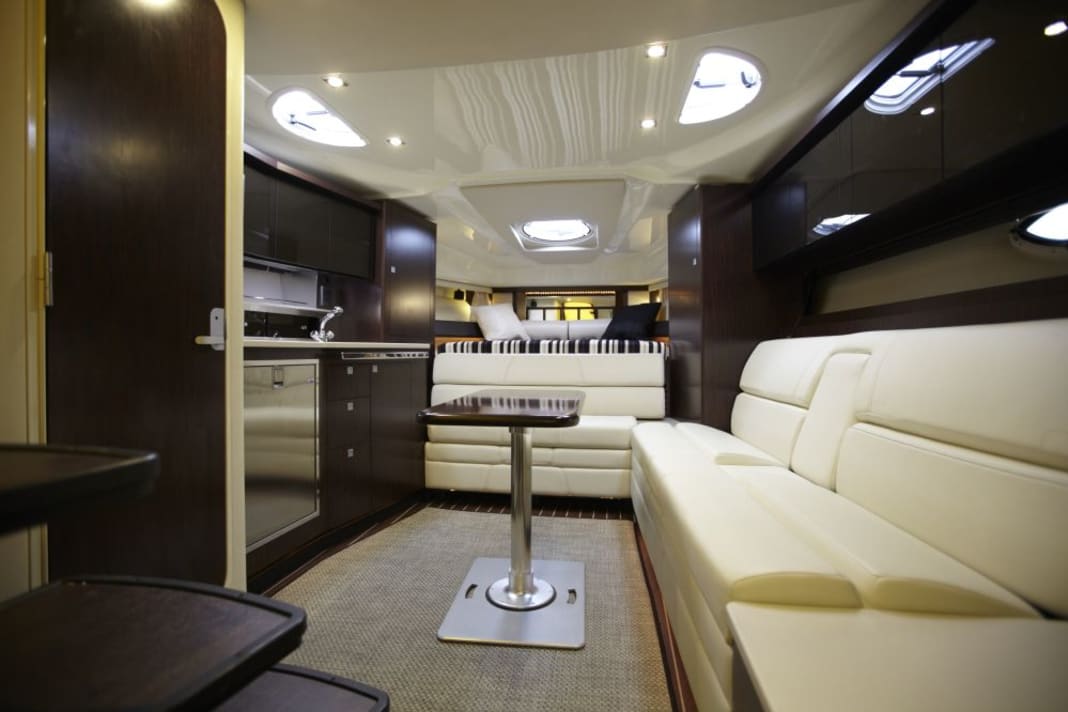







The designers of the Monterey 355 SY can definitely be described as keen to experiment. This applies not only to the "UFO-shaped" roof above the cockpit, but also to the modern interior design, which the shipyard itself describes as "away from the conventional cabin layout and towards a spacious and inviting layout".
The test boat offers sleeping space for five people. Two are in the bow, two in the underfloor cabin and another crew member in the saloon seating area. The galley and wet room provide additional living comfort. Under the hardtop, the designer has integrated a wetbar, sunbed, seating area and the driving position. In other words, a "cruising boat for excursions of all kinds".
With the CE category B classification, trips outside of coastal waters, such as trips to the Baltic Sea island of Bornholm, are easily possible. It goes without saying that you need a solid boat for this. The test Monterey impresses in this respect with its good plastic workmanship, with only a few laminate tips on the inside, and stable cleat fastening with bolts that are screwed through reinforced laminate. Less good is the railing support fastening with self-tapping screws. Below deck, the furniture has even gaps and only a few silicone seams.
Driving and manoeuvring
"Typically American" is the motorisation with two petrol engines. On our test boat, Monterey installed a V-8 duo from Volvo Penta with 300 hp each. If you want an engine with Volvo diesels of the same power, you have to pay a hefty surcharge of almost 80,000 euros. Those who opt for petrol engines have a choice of seven MerCruiser models in addition to the Volvo engines.
Our test Volvos bring the 355 SY from displacement to planing speed between around 2000 rpm and 3500 rpm. To organise this phase as quickly as possible and with as little visual obstruction as possible, the trim tabs and power trim should be in the "down" position. When gliding (from around 3500 rpm), the trim tabs are only required for weight or wind equalisation. The power trim is then increased from -5 to around +3 (on the Volvo display) up to the maximum speed of a good 5000 rpm. The latter is slightly higher than the maximum speed permitted by the manufacturer - but due to the low load, this is an acceptable circumstance.
At full throttle, the Monterey reaches a brisk 40 knots, with the two engines consuming 3.85 l/sm, which, with a tank capacity of just under 800 litres minus 15% reserve, gives a range of 175 nm. Just under 40 nautical miles further is possible at an economical planing speed of 4000 rpm at almost 29 knots. That is a range of over 200 nm - for example the distance between Marseille and Menorca's north coast.
Our test area proved to be moderately choppy with water churned up by commercial vessels. The Monterey travelled through these waves at a good 30 knots smoothly, stable and without excessive spray. Fast, tight bends can be safely negotiated with and without a trimmed sterndrive and trim tabs without rocking or bobbing. Steering out is only easy at the narrowest point of the circle, before that there is a lot of pressure on the rudder and you have to apply force.
This effect does not occur on larger bends, such as turning on the Rhine. In the harbour, the steering wheel is very easy to turn and the turning circles are a maximum of 1 ½ boat lengths when engaged forwards and 1 boat length when reversing - typical dimensions. Oppositely engaged gearboxes ensure direct reversing behaviour. If both are engaged forwards and the engines are running at the same speed, the Monterey remains stable even at displacement speeds.
To prevent the stern wave from reaching a height that threatens the shore, the 1500 rpm (7.3 knots) must not be exceeded. The revs can be read twice for each engine: once on the Monterey rev counter and also on the Volvo Penta instruments. In addition to the operating states, the latter also show the fuel consumption. Apart from minor reflections, the Monterey instruments are easy to read. The Volvo displays and the "Raymarine Bidata" partially cover the steering wheel. The switches and trim tab panel are just as easy to operate as the elegantly designed sports steering wheel and the well-mounted EVC gearstick, which is child's play to operate.
The front passenger and driver sit on a kind of double bench with individually designed bucket seats. Their upholstery is sporty and firm, armrests provide the necessary lateral support, and an incline with an anti-slip structure serves as a footrest. Both fold up the front part of the seat for a relaxed ride when standing. Wind protection is provided by a safety windscreen that sits in a painted system frame. Reflections in the windscreen are minimal due to the dark driving position. A windscreen wiper ensures sufficient visibility in the rain. There is no defroster or windscreen washer system.
Engine, tank, electrics
The engine compartment can be conveniently opened electrically at the touch of a button. However, you must not forget to open the rear door first, the latch of which fits into the side wall. Practical: In the event of a power failure or other problems with the drive, the bonnet can be unlocked and opened via an emergency hatch. The engine compartment offers plenty of space for service work, but we searched in vain for sound insulation. Despite this, the maximum noise level of 85 dB/A remains within an acceptable range.
The installations in the engine compartment make a good impression. The technicians secure the lines and hoses firmly and clearly. The fuel tank is held in place by metal straps, while the fuel hose connections - apart from those directly on the engines - are secured by two screw clamps. A filter cartridge on each engine cleans the petrol. Four 88 Ah batteries, which are charged via diode distributors with an alternator or 40 A charger, provide the 12 V supply.
Electronically operated main switches separate the consumers from the batteries. The rocker switches on the control centre in the saloon are used for this purpose. Exemplary: Manual emergency operation is also possible using the switch located in the engine compartment. Fuses can be found in the engine compartment, on the driving position and on the aforementioned saloon control centre.
Security
The automatic fire extinguishing system plus hand-held fire extinguisher is highly praised. Three electric bilge pumps are a convenient feature, but the important manual bilge pump, which also works in the event of a power failure, was not available. To ensure safe movement on board, all steps are fitted with anti-slip structures or carpeting. Handrails are also provided. There are three ways to access the foredeck: twice via narrow side decks and once via the centre passageway with sufficiently wide steps and moderate headroom to the hardtop.
Living, cockpit and equipment
In the stern of the boat, the designer has integrated a large bathing platform with stern shower into the hull. A ladder can be found under a flap, which on our test boat kept closing by itself. This is unfavourable, especially when unfolding the ladder from the water. Adjacent to the bathing platform is a sun lounger with railing, which can be practically extended using the variable backrest of the stern bench. Its cushions are just as sporty and firm as the entire seating area in the cockpit. Further sun loungers can be found in the cockpit at the front on the port side and on the foredeck on the cabin roof. A wet bar with sink, drinks holder and storage compartments plus cool box under the starboard bench provides snacks and refreshments in the open-air area.
Below deck, the designer accommodated a double berth in the bow, which can only be separated from the saloon by curtains. The same applies to the underfloor cabin, which offers space for two travelling children. There is a table at the convertible (single berth) L-shaped seating area, which is very small for dining for four. Cooking is done on a galley block, which is suitably equipped with a stainless steel sink (with lid), refrigerator (with integrated freezer compartment), 2-plate ceramic hob, microwave and coffee machine. If you also want to use the electrical appliances at the anchorage, you will have to pay around 15,500 (petrol) and a good 20,000 (diesel) euros extra for a generator.
An electric pump toilet, shower and deep stainless steel basin are standard in the wet room. In the wet room, as in the entire boat, there is a suitable number and size of storage areas. Other standard equipment includes a television in the saloon, the hardtop with retractable side panels and navigation lighting, although this only fulfils the American standard.
THE SHIPYARD SAYS...
The Monterey 355 is one of the most popular models in the sports yacht range. This is partly due to its special design and practical berth arrangement. Our boat builders
guarantee a high degree of care in addition to proven technology and quality-orientated processes, which ensures the 355 SY a top position on the cruiser market.
WE SAY...
The Monterey 355 SY is suitably divided for two adults and two children. In terms of quality, it meets good American standards and, with the specified engine, offers good handling and a decent range. Equipping it with a diesel engine would increase the latter enormously - but then a considerable surcharge would be due.
Data sheet: Monterey 355 Sport Yacht
Shipyard: Monterey Boats
Type designation: Monterey 355 Sport Yacht
CE category: B - Outside coastal waters
Material of hull and deck: Plastic
Length: 10,70 m
Width: 3,40 m
Displacement: 6,67 t
Price: 264.135,00 €

